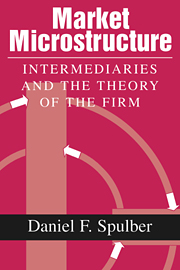Book contents
- Frontmatter
- Contents
- Preface and acknowledgments
- Introduction
- Part I Market microstructure and the intermediation theory of the firm
- Part II Competition and market equilibrium
- Part III Intermediation versus decentralized trade
- Part IV Intermediation under asymmetric information
- Part V Intermediation and transaction-cost theory
- Part VI Intermediation and agency theory
- Conclusion
- References
- Index
Conclusion
Published online by Cambridge University Press: 18 December 2009
- Frontmatter
- Contents
- Preface and acknowledgments
- Introduction
- Part I Market microstructure and the intermediation theory of the firm
- Part II Competition and market equilibrium
- Part III Intermediation versus decentralized trade
- Part IV Intermediation under asymmetric information
- Part V Intermediation and transaction-cost theory
- Part VI Intermediation and agency theory
- Conclusion
- References
- Index
Summary
Money may be the oil of commerce, but intermediaries are its engine. Financial, wholesale, and retail intermediaries and marketing, sales, and purchasing units of vertically integrated manufacturers carry out a wide variety of intermediation activities that are essential to the functioning of market economies. The preceding chapters define an intermediation theory of the firm that explains why firms are formed and how their boundaries are determined. The analysis also provides an intermediation theory of market microstructure that helps to explain how prices are determined and how supply and demand are brought into balance in a market equilibrium.
The intermediation approach extends and unifies in a consistent way the four main classes of theories of the firm: neoclassical, industrial organization, contractual, and organization incentive. Of course, any unifying view emphasizes some features of models at the expense of others, treating some settings as special cases or ideal conditions. The intermediation theory of the firm provides sufficient generality that it retains some of the fundamental features of existing theories of the firm.
The intermediation theory of the firm retains the input–output perspective of neoclassical economics, focusing on not only the firm's role as a producer but also on an additional set of activities. Like the neoclassical firm, coordination of the purchase of inputs and sale of outputs is stressed. Unlike the neoclassical setting, firms do not necessarily take all prices as given. Firms, rather than the Walrasian auctioneer, operate markets, coordinate the activities of buyers and sellers, select prices, and balance supply and demand.
- Type
- Chapter
- Information
- Market MicrostructureIntermediaries and the Theory of the Firm, pp. 344 - 352Publisher: Cambridge University PressPrint publication year: 1999



